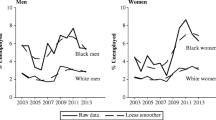Abstract
This article analyzes the effects of changes in flows into and out of unemployment on the growing gap between black and white unemployment rates in the 1970s and 1980s. Current Population Survey data show that black workers’ unemployment inflows increased, suggesting that job instability increased. Declining employment opportunities were also implicated, as black workers left unemployment for a job less often in 1987 than in 1971. White women’s situation improved considerably, with lower inflows and higher employment probabilities. Although the effects of declining federal equal employment opportunity (EEO) pressure cannot be detected, these findings are consistent with increasing racial discrimination.
Similar content being viewed by others
Notes
See JohnBound and Richard B.Freeman “Black Economic Progress: Erosion of the Post-1965 Gains in the 1980’s?” inThe Question of Discrimination, StevenShulman and WilliamDarity, Jr., (eds.) (Middletown, CT: Wesleyan University Press, 1989); John H. Donohue and James Heckman, “Continuous Versus Episodic Change: The Impact of Civil Rights Policy on the Economic Status of Blacks,”Journal of Economic Literature, XXIX (December 1991).
Gerald D.Jaynes, “The Labor Market Status of Black Americans: 1939–1985,”The Journal of Economic Perspectives, 4 (4) (1990), 9–24.
Some recent work does examine racial differences in male teenage unemployment rates, e.g., Harry J.Holzer, “Black Youth Nonemployment: Duration and Job Search,” inThe Black Youth Employment Crisis, Richard B.Freeman and Harry J. Holzer (eds.) (Chicago: The University of Chicago Press, 1986).
Robert Hall, “Turnover in the Labor Force,”Brookings Papers on Economic Activity, 3 (1972); Stephen T. Marston, “Employment Instability and High Unemployment Rates,”Brookings Papers on Economic Activity, 1 (1976); Clair Vickery, “The Impact of Turnover on Group Unemployment Rates,”Review of Economics and Statistics, 59 (November 1977).
Robert Hall, “Turnover in the Labor Force,”Brookings Papers on Economic Activity, 3 (1972); Stephen T. Marston, “Employment Instability and High Unemployment Rates,”Brookings Papers on Economic Activity, 1 (1976); Clair Vickery, “The Impact of Turnover on Group Unemployment Rates,”Review of Economics and Statistics, 59 (November 1977).
Chinhui Juhn, “Decline of Male Labor Market Participation: The Role of Declining Market Opportunities,”The Quarterly Journal of Economics (February 1992), 79-121.
John Kasarda, “Urban Industrial Transition and the Underclass,”Annals of the American Academy of Political and Social Science (January 1989); John Bound and Harry Holzer, “Industrial Shifts, Skills Levels, and the Labor Market for White and Black Males,” NBER Working Paper No. 3715, (1991).
Lori G. Kletzer, “Job Displacement, 1979–86: How Blacks Fared Relative to Whites,”Monthly Labor Review (July 1991).
M. V. LeeBadgett, “Racial Differences in Unemployment Rates and Employment Opportunities” (Ph.D. dissertation, Berkeley: University of California, 1990).
Juhn, op. cit.
Jonathan Leonard, “The Impact of Affirmative Action Regulation and Equal Employment Law on Black Employment,”Journal of Economic Perspectives, 4 (Fall 1990).
See Bound and Freeman, op. cit.; Donohue and Heckman, op. cit.
Jeremy I. Bulow and Lawrence H. Summers, “A Theory of Dual Labor Markets with Application to Industrial Policy, Discrimination, and Keynesian Unemployment,”Journal of Labor Economics, 4 (1986).
Francine D. Blau and Andrea H. Beller, “Black-White Earnings Over the 1970’s and 1980’s: Gender Differences in Trends,” NBER Working Paper No. 3736 (June 1991).
Jonathan Leonard, “Women and Affirmative Action,”Journal of Economic Perspectives, 3 (Winter 1989).
William T.Dickens and KevinLang, “Why It Matters What We Trade: A Case for Active Policy,” inThe Dynamics of Trade and Employment, Laura D.Tyson, William T.Dickens, and JohnZysman (eds.) (Cambridge, MA: Ballinger Publishing Co., 1988).
Labor force percentages and labor force participation rates are fromEconomic Report of the President (Washington: United States Government Printing Office, 1991).
Steven Shulman, “Competition and Racial Discrimination: The Employment Effects of Reagan’s Labor Market Policies,”Review of Radical Political Economics, 16 (4) (1984); Shulman, “Racial Inequality and White Employment: An Interpretation and Test of the Bargaining Power Hypothesis,”The Review of Black Political Economy, 18 (Winter 1990), 5-20.
Olivier Jean Blanchard and Peter Diamond, “The Beveridge Curve,”Brookings Papers on Economic Activity, 1 (1989).
These measurements were created and used most extensively by Michael R. Darby, John Haltiwanger, and Mark Plant, “Unemployment Rate Dynamics and Persistent Unemployment Under Rational Expectations,”American Economic Review, 75 (4) (1985).
For derivation of equations (3) and (4), see These measurements were created and used most extensively by Michael R. Darby, John Haltiwanger, and Mark Plant, “Unemployment Rate Dynamics and Persistent Unemployment Under Rational Expectations,”American Economic Review, 75 (4) (1985)., or Badgett, op. cit.
Separate data on black workers was not published until 1983. The distinction between “black” and “black and other” has become more important in recent years. In March 1971, for instance, blacks made up 90% of the black and other group. By March 1987, however, blacks were only 78.2% of black and other. Unless otherwise noted, “black” will actually refer to the “black and other” group.
Larry DeBoer and Michael C. Seeborg, “The Unemployment Rates of Men and Women: A Transition Probability Analysis,”Industrial and Labor Relations Review, 42 (3) (1989).
For a broader discussion of this hypothesis, see M. V. Lee Badgett and Rhonda M.Williams, “The Changing Contours of Discrimination: Race, Gender, and Structural Economic Change,” inUnderstanding American Economic Decline, DavidAdler and MichaelBernstein (eds.) (Cambridge: Cambridge University Press, forthcoming, 1994).
About this article
Cite this article
Badgett, M.V.L. Rising black unemployment: Changes in job stability or in employability?. The Review of Black Political Economy 22, 55–75 (1994). https://doi.org/10.1007/BF02689973
Issue Date:
DOI: https://doi.org/10.1007/BF02689973




